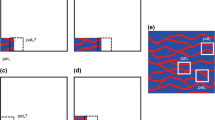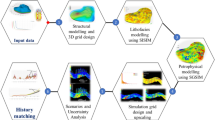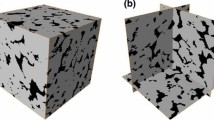Abstract
Usage of an advanced geostatistical method for reservoir characterization results in more reliable insights of reservoir performance. Multiple-point statistic (MPS) methods which borrow ideas of texture synthesis could mimic the variation of complex reservoir permeability. This study implements this complex variation of permeability for enhanced oil recovery (EOR) purposes. Thermal EOR which reduces the viscosity of reservoir could be nominated as one of possible EOR method for any reservoir. The effect of high-order statistics of permeability is studied against the variation of oil viscosity. To this end, a modified version of SPE 10 model-1 is used to apply a thermal EOR scenario. Constant rate water injection creates a front of water which moves through the reservoir based on synthesized MPS-derived permeabilities as well as the reference case. In this study, multi-scale cross-correlation-based simulation (MSCCSIM) and image quilting (IQ) are selected for generating reservoir permeability. The results show that synthesized permeability map is able to create a correct trend of oil production rate for whole reservoir life compared with the reference case. However, similar behavior at one oil viscosity value does not guarantee similar behavior of reservoir for another set of oil viscosity values. For highly viscose oil reservoir, reference permeability shows later water breakthrough than oil with normal viscosity while in synthesized permeability, water breakthrough happens earlier for oil with normal viscosity. This indicates the uncertainty of EOR scenario prediction due to imperfectness of MPS methods for characterizing the studied reservoir. Incidentally, as an important advantage, the reference general shape of water front and saturation spectrum is satisfactorily regenerated by one of MPS methods. Moreover, flanging and fingering of water front are mimicked to some acceptable extent.















Similar content being viewed by others
References
Ado MR, Greaves M, Rigby SP (2019) Numerical simulation of the impact of geological heterogeneity on performance and safety of THAI heavy oil production process. J Pet Sci Eng 173:1130–1148. https://doi.org/10.1016/j.petrol.2018.10.087
Al-Mudhafar WJ, Rao DN, Srinivasan S (2018) Reservoir sensitivity analysis for heterogeneity and anisotropy effects quantification through the cyclic CO2-assisted gravity drainage EOR process – a case study from south Rumaila oil field. Fuel 221:455–468. https://doi.org/10.1016/j.fuel.2018.02.121
Al Bahlani AM, Babadagli T Heavy-oil recovery in naturally fractured reservoirs with varying wettability by steam solvent co-injection. In: International Thermal Operations and Heavy Oil Symposium, 2008 1 2008. Society of Petroleum Engineers. doi:https://doi.org/10.2118/117626-MS
Altunina L, Kuvshinov V (2008) Improved oil recovery of high-viscosity oil pools with physicochemical methods and thermal-steam treatments. Oil Gas Sci Technol 63:37–48. https://doi.org/10.2516/ogst:2007075
Alvarado V, Ranson A, Hernandez K, Manrique E, Matheus J, Liscano T, Prosperi N (2002) Selection of EOR/IOR opportunities based on machine learning. In: European Petroleum Conference. Society of Petroleum Engineers. https://doi.org/10.2118/78332-MS
Amirian E, Leung JY, Zanon S, Dzurman P (2015) Integrated cluster analysis and artificial neural network modeling for steam-assisted gravity drainage performance prediction in heterogeneous reservoirs. Expert Syst Appl 42:723–740. https://doi.org/10.1016/j.eswa.2014.08.034
Azamifard A, Rashidi F, Ahmadi M, Pourfard M, Dabir B (2019a) Toward more realistic models of reservoir by cutting-edge characterization of permeability with MPS methods and deep-learning-based selection. J Pet Sci Eng 181:106135. https://doi.org/10.1016/j.petrol.2019.05.086
Azamifard A, Rashidi F, Pourfard M, Ahmadi M, Dabir B (2019b) Enduring effect of permeability texture for enhancing accuracy and reducing uncertainty of reservoir fluid flow through porous media. Pet Sci. https://doi.org/10.1007/s12182-019-00366-4
Caers J (2001) Geostatistical reservoir modelling using statistical pattern recognition. J Pet Sci Eng 29:177–188. https://doi.org/10.1016/S0920-4105(01)00088-2
Castanier L, Brigham W (2003) Upgrading of crude oil via in situ combustion. J Pet Sci Eng 39:125–136. https://doi.org/10.1016/S0920-4105(03)00044-5
Chen Z, Wang L, Duan Q, Zhang L, Ren S (2013) High-pressure air injection for improved oil recovery: low-temperature oxidation models and thermal effect. Energy Fuels 27:780–786. https://doi.org/10.1021/ef301877a
Christie M, Blunt M (2001) Tenth SPE comparative solution project: a comparison of upscaling techniques. In: SPE Reservoir Simulation Symposium. Society of Petroleum Engineers. https://doi.org/10.2118/66599-MS
Dong X, Liu H, Chen Z, Wu K, Lu N, Zhang Q (2019) Enhanced oil recovery techniques for heavy oil and oilsands reservoirs after steam injection. Appl Energy 239:1190–1211. https://doi.org/10.1016/j.apenergy.2019.01.244
Efros AA, Freeman WT (2001) Image quilting for texture synthesis and transfer. In: Proceedings of the 28th annual conference on Computer graphics and interactive techniques. ACM, pp 341–346. https://doi.org/10.1145/383259.383296
Green DW, Willhite GP (1998) In: Henry L (ed) Enhanced oil recovery vol 6. Doherty Memorial Fund of AIME, Society of Petroleum Engineers, Richardson
Hu L, Chugunova T (2008) Multiple-point geostatistics for modeling subsurface heterogeneity: a comprehensive review. Water Resour Res:44. https://doi.org/10.1029/2008WR006993
Huang J, ** T, Chai Z, Barrufet M, Killough J (2019) Compositional simulation of fractured shale reservoir with distribution of nanopores using coupled multi-porosity and EDFM method J Pet Sci Eng 179:1078–1089 doi:https://doi.org/10.1016/j.petrol.2019.05.012
Hui M-HR, Karimi-Fard M, Mallison B, Durlofsky LJ (2017) A general modeling framework for simulating complex recovery processes in fractured reservoirs at different resolutions. Paper presented at the SPE Reservoir Simulation Conference, Montgomery, Texas, USA, 2017/2/20/
Liu Y, Chen S, Guan B, Xu P (2019) Layout optimization of large-scale oil–gas gathering system based on combined optimization strategy. Neurocomputing 332:159–183. https://doi.org/10.1016/j.neucom.2018.12.021
Mahmud K, Mariethoz G, Caers J, Tahmasebi P, Baker A (2014) Simulation of Earth textures by conditional image quilting. Water Resour Res 50:3088–3107. https://doi.org/10.1002/2013WR015069
Mariethoz G, Caers J (2014) Multiple-point geostatistics: stochastic modeling with training images. John Wiley & Sons. https://doi.org/10.1002/9781118662953
Mariethoz G, Lefebvre S (2014) Bridges between multiple-point geostatistics and texture synthesis: review and guidelines for future research. Comput Geosci 66:66–80. https://doi.org/10.1016/j.cageo.2014.01.001
Mariethoz G, Renard P, Straubhaar J (2010) The direct sampling method to perform multiple-point geostatistical simulations. Water Resour Res:46. https://doi.org/10.1029/2008WR007621
Matheron G (1973) The intrinsic random functions and their applications. Adv Appl Probab 5:439–468. https://doi.org/10.2307/1425829
Menad NA, Noureddine Z, Hemmati-Sarapardeh A, Shamshirband S (2019) Modeling temperature-based oil-water relative permeability by integrating advanced intelligent models with grey wolf optimization: application to thermal enhanced oil recovery processes. Fuel 242:649–663. https://doi.org/10.1016/j.fuel.2019.01.047
Moreno JE, Gurpinar OM, Liu Y, Al-Kinani A, Cakir N (2014) EOR advisor system: a comprehensive approach to EOR selection. Paper presented at the International Petroleum Technology Conference, Kuala Lumpur, Malaysia, 2014/12/10/
Moura P et al (2017) LSHSIM: a locality sensitive hashing based method for multiple-point geostatistics. Comput Geosci:49–60. https://doi.org/10.1016/j.cageo.2017.06.013
Pal S, Mushtaq M, Banat F, Al Sumaiti AM (2018) Review of surfactant-assisted chemical enhanced oil recovery for carbonate reservoirs: challenges and future perspectives. Pet Sci 15:77–102. https://doi.org/10.1007/s12182-017-0198-6
Pourfard M, Abdollahifard MJ, Faez K, Motamedi SA, Hosseinian T (2016) PCTO-SIM: multiple-point geostatistical modeling using parallel conditional texture optimization. Comput Geosci:102–116. https://doi.org/10.1016/j.cageo.2016.12.012
Pyrcz MJ, Deutsch CV (2014) Geostatistical reservoir modeling. Oxford university press
Rostami A, Baghban A, Mohammadi AH, Hemmati-Sarapardeh A, Habibzadeh S (2019) Rigorous prognostication of permeability of heterogeneous carbonate oil reservoirs: smart modeling and correlation development. Fuel 236:110–123. https://doi.org/10.1016/j.fuel.2018.08.136
Sharifzadehlari M, Fathianpour N, Renard P, Amirfattahi R (2018) Random partitioning and adaptive filters for multiple-point stochastic simulation. Stoch Env Res Risk Assess 32:1375–1396. https://doi.org/10.1007/s00477-017-1453-5
Strebelle S (2002) Conditional simulation of complex geological structures using multiple-point statistics. Math Geol 34:1–21. https://doi.org/10.1023/A:1014009426274
Tahmasebi P, Hezarkhani A, Sahimi M (2012a) Multiple-point geostatistical modeling based on the cross-correlation functions. Comput Geosci 16:779–797. https://doi.org/10.1007/s10596-012-9287-1
Tahmasebi P, Kamrava S (2018) A multiscale approach for geologically and flow consistent modeling. Transp Porous Media 124:237–261. https://doi.org/10.1007/s11242-018-1062-x
Tahmasebi P, Sahimi M (2016) Enhancing multiple-point geostatistical modeling: 1. Graph theory and pattern adjustment. Water Resour Res 52:2074–2098. https://doi.org/10.1002/2015WR017806
Tahmasebi P, Sahimi M, Caers J (2014) MS-CCSIM: accelerating pattern-based geostatistical simulation of categorical variables using a multi-scale search in Fourier space. Comput Geosci 67:75–88. https://doi.org/10.1016/j.cageo.2014.03.009
Tahmasebi P, Sahimi M, Mariethoz G, Hezarkhani A (2012b) Accelerating geostatistical simulations using graphics processing units (GPU). Comput Geosci 46:51–59. https://doi.org/10.1016/j.cageo.2012.03.028
Thomas S (2008) Enhanced oil recovery-an overview. Oil Gas Sci Technol 63:9–19. https://doi.org/10.2516/ogst:2007060
Wang Z, Bai Y, Zhang H, Liu Y (2019) Investigation on gelation nucleation kinetics of waxy crude oil emulsions by their thermal behavior. J Pet Sci Eng 181:106230. https://doi.org/10.1016/j.petrol.2019.106230
Yang L, Hou W, Cui C, Cui J (2016) GOSIM: a multi-scale iterative multiple-point statistics algorithm with global optimization. Comput Geosci 89:57–70. https://doi.org/10.1016/j.cageo.2015.12.020
Yannimaras D, Tiffin D (1995) Screening of oils for in-situ combustion at reservoir conditions via accelerating rate calorimetry. SPE Reserv Eng 10:36–39. https://doi.org/10.2118/27791-PA
Zhang T, Switzer P, Journel A (2006) Filter-based classification of training image patterns for spatial simulation. Math Geol 38:63–80. https://doi.org/10.1007/s11004-005-9004-x
Zhao DW, Wang J, Gates ID (2014) Thermal recovery strategies for thin heavy oil reservoirs. Fuel 117:431–441. https://doi.org/10.1016/j.fuel.2013.09.023
Author information
Authors and Affiliations
Corresponding author
Additional information
Responsible Editor: Ray Rui
Rights and permissions
About this article
Cite this article
Azamifard, A., Ahmadi, M., Rashidi, F. et al. Insights of new-generation reservoir property modeling (MPS methods) in assessing the reservoir performance for different recovery methods. Arab J Geosci 13, 302 (2020). https://doi.org/10.1007/s12517-020-05293-y
Received:
Accepted:
Published:
DOI: https://doi.org/10.1007/s12517-020-05293-y




